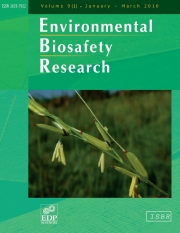Crossref Citations
This article has been cited by the following publications. This list is generated based on data provided by
Crossref.
YOSHIMURA, YASUYUKI
MIZUGUTI, AKI
and
MATSUO, KAZUHITO
2011.
Analysis of the seed dispersal patterns of wild soybean as a reference for vegetation management around genetically modified soybean fields.
Weed Biology and Management,
Vol. 11,
Issue. 4,
p.
210.
Mizuguti, Aki
2011.
Fundamental study for ecological risk assessment and evaluation of genetically modified crops, especially soybean (Glycine max) and canola (Brassica napus) in Japan..
Journal of Weed Science and Technology,
Vol. 56,
Issue. 2,
p.
100.
2012.
Scientific Opinion on an application (EFSA‐GMO‐NL‐2005‐24) for the placing on the market of the herbicide tolerant genetically modified soybean 40‐3‐2 for cultivation under Regulation (EC) No 1829/2003 from Monsanto.
EFSA Journal,
Vol. 10,
Issue. 6,
Nicolia, Alessandro
Manzo, Alberto
Veronesi, Fabio
and
Rosellini, Daniele
2014.
An overview of the last 10 years of genetically engineered crop safety research.
Critical Reviews in Biotechnology,
Vol. 34,
Issue. 1,
p.
77.
Wang, Ke-Jing
Li, Xiang-Hu
and
Yan, Mao-Fen
2014.
Microsatellite markers reveal genetic diversity of wild soybean in different habitats and implications for conservation strategies (Glycine soja) in China.
Conservation Genetics,
Vol. 15,
Issue. 3,
p.
605.
2014.
Scientific Opinion on application (EFSA‐GMO‐NL‐2009‐64) for the placing on the market of herbicide‐tolerant genetically modified soybean BPS‐CV127‐9 for food and feed uses, import and processing under Regulation (EC) No 1829/2003 from BASF Plant Science.
EFSA Journal,
Vol. 12,
Issue. 1,
Park, Hae-Rim
Yook, Min-Jung
and
Kim, Do-Soon
2016.
Characterization of Soybean Hybrid Seeds Resulted from Natural Hybridization between LM Soybean and Wild Soybean.
Weed & Turfgrass Science,
Vol. 5,
Issue. 4,
p.
196.
Goto, Hidetoshi
McPherson, Marc A.
Comstock, Bradley A.
Stojšin, Duška
and
Ohsawa, Ryo
2017.
Likelihood assessment for gene flow of transgenes from imported genetically modified soybean (<i>Glycine max</i> (L.) Merr.) to wild soybean (<i>Glycine soja</i> Seib. et Zucc.) in Japan as a component of environmental risk assessment.
Breeding Science,
Vol. 67,
Issue. 4,
p.
348.
Kim, Hye Jin
Kim, Do Young
Moon, Ye Seul
Pack, In Soon
Park, Kee Woong
Chung, Young Soo
Kim, Young Joong
Nam, Kyong-Hee
and
Kim, Chang-Gi
2019.
Gene flow from herbicide resistant transgenic soybean to conventional soybean and wild soybean.
Applied Biological Chemistry,
Vol. 62,
Issue. 1,
Sano, Saki
Nakayama, Yuichiro
Nogami, Tatsuya
and
Yagyu, Atsushi
2019.
Flowering phenology and seed production of an alpine plant (<i>Plantago hakusanensis</i> Koidz.), a domestic alien plant (<i>P. asiatica </i>L.), and their hybrids on Mt. Hakusan, Japan.
Journal of Weed Science and Technology,
Vol. 64,
Issue. 3,
p.
73.
Oh, Sung-Dug
Park, Soo-Yun
Lee, Seong-Kon
Yun, Doh-Won
Lee, Gang-Seob
and
Suh, Sang Jae
2020.
Influence of Vitamin A-enhanced Transgenic Soybean Cultivation on the Diversity of Insects in LMO Quarantine Fields.
Korean Journal of Breeding Science,
Vol. 52,
Issue. 4,
p.
310.
Tian, Lei
Shi, Shaohua
Ma, Lina
Tran, Lam-Son Phan
and
Tian, Chunjie
2020.
Community structures of the rhizomicrobiomes of cultivated and wild soybeans in their continuous cropping.
Microbiological Research,
Vol. 232,
Issue. ,
p.
126390.
Courtier‐Orgogozo, Virginie
Danchin, Antoine
Gouyon, Pierre‐Henri
and
Boëte, Christophe
2020.
Evaluating the probability of CRISPR‐based gene drive contaminating another species.
Evolutionary Applications,
Vol. 13,
Issue. 8,
p.
1888.
Oh, Sung-Dug
Jang, Ye-Jin
Lee, Gyeong Min
Lee, Kijong
Suh, Sang Jae
Ryu, Tae-Hoon
and
Park, Soo-Yun
2020.
Comparison of the Nutritional Compositions of hybrid Soybean between β–carotene Enhanced Transgenic Soybean and wild Soybean.
Journal of the Korean Society of International Agricultue,
Vol. 32,
Issue. 4,
p.
339.
Oh, Sung-Dug
Jang, Ye-Jin
Park, Soo-Yun
Lee, Kijong
Lee, Seong-Kon
Yun, Doh-Won
Suh, Sang Jae
and
Chae, Jong-Chan
2021.
Assessment of the effect on soil microbial communities of genetically modified soybean and a hybrid from crossing with wild soybean.
Plant Biotechnology Reports,
Vol. 15,
Issue. 6,
p.
855.
Umurzokov, Mirjalol
Bo Bo, Aung
Ruziev, Farrukh
Jia, Wei Qiang
Le, ThiHien
Cho, Min Kwang
Khaitov, Botir
and
Park, Kee Woong
2021.
Pollen-mediated exclusive gene flow from transgenic crops.
International Journal of Pest Management,
Vol. 67,
Issue. 3,
p.
260.
Nam, Kyong-Hee
Kim, Do Young
Pack, In Soon
and
Kim, Chang-Gi
2021.
Compositional differences in hybrids between protoporphyrinogen IX oxidase (PPO)-inhibiting herbicide-resistant transgenic rice and weedy rice accessions.
Food Chemistry,
Vol. 344,
Issue. ,
p.
128584.
Kim, Do Young
Heo, Jin Ho
Pack, In Soon
Park, Jung-Ho
Um, Min Shik
Kim, Hye Jin
Park, Kee Woong
Nam, Kyong-Hee
Oh, Sung Duk
Kim, Jae Kwang
Seo, Ju Seok
and
Kim, Chang-Gi
2021.
Natural hybridization between transgenic and wild soybean genotypes.
Plant Biotechnology Reports,
Vol. 15,
Issue. 3,
p.
299.
Liu, Jin Yue
Sheng, Ze Wen
Hu, Yu Qi
Liu, Qi
Qiang, Sheng
Song, Xiao Ling
and
Liu, Biao
2021.
Fitness of F1 hybrids between 10 maternal wild soybean populations and transgenic soybean.
Transgenic Research,
Vol. 30,
Issue. 1,
p.
105.
Yook, Min-Jung
Park, Hae-Rim
Zhang, Chuan-Jie
Lim, Soo-Hyun
Jeong, Soon-Chun
Chung, Young Soo
and
Kim, Do-Soon
2021.
Environmental risk assessment of glufosinate-resistant soybean by pollen-mediated gene flow under field conditions in the region of the genetic origin.
Science of The Total Environment,
Vol. 762,
Issue. ,
p.
143073.


